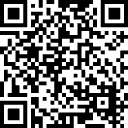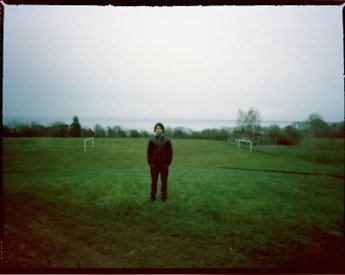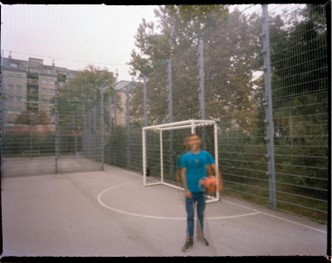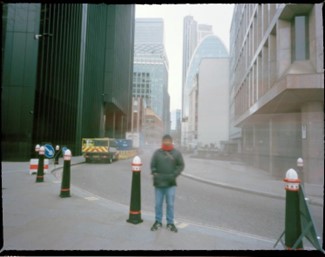Birmingham in August can feel like October in my native Italy. I was taking a stroll through the city centrein, but the rain and wind forced me to take shelter in the public library. As the howling wind rattled the windows, I walked slowly through the hallways on the top floor filled with books and glass doors. This is where I met Alan Gignoux, the award-winning photographer and producer of documentary photography and films devoted to socio-political and environmental issues around the world. He was there because the library was the venue of his exhibition of photography titled “You can see me, but I don’t exist”. The images had been shot with a pinhole camera and portrayed asylum seekers living in limbo in the cities of Europe. What incredible stroke of luck! It was thanks to the foul weather that I got to meet Alan. After a long chat, I took out my smartphone and asked him whether I could interview him. He graciously accepted. The transcript is below.
Why an exhibition of photography about refugees?
I first became interested in the difficult circumstances of refugees in 2003 in Lebanon, where I witnessed the large number of Palestinian refugees living in camps around the city. I visited the Sabra and Shatila refugee camps, where the notorious Israeli massacre occurred on 16th September 1982: here 2,000 to 3,500 refugees and Lebanese citizens were killed by a right-wing Lebanese militia in coordination with the Israeli army. I was horrified by the conditions in the camps and by the sheer number of people crammed into such a small space. I met people in their fifties and sixties who had lived almost their entire lives in the camps and saw no prospect of ever returning home or getting citizenship in Lebanon or elsewhere. I wanted to find a way of getting to the heart of the Palestinian question and demonstrating the pain of exile being experienced by the refugees, while at the same time portraying them as individuals, rather than a faceless group.
With funding from the British Council in East Jerusalem, I traveled around the Middle East photographing Palestinians in the refugee camps and then went to Israel to photograph their former homes and villages in what is today Israel, to show what has happened to their houses, agricultural lands, and former communities. I then presented the portraits and landscape images in pairs, allowing them to come together in the gallery space in a way which has not been possible in the real world since 1948. The exhibition, titled Homeland Lost, was exhibited extensively in the Middle East, including Israel, and in London, Amsterdam, and Ypres. The curator for this project was Jenny Christensson, who was also the project leader for “You can see me, but I don’t exist” in the UK. On both projects, Jenny and I worked together on research and creative conceptualisation as well as planning and execution.
I continued with the Homeland Lost concept by looking at another long-term refugee situation – the Saharawi, who have been exiled to refugee camps in the desert outside Tindouf since 1975, with the promised referendum on self-determination in Western Sahara delayed indefinitely. I have visited the Saharawi refugee camps in Algeria regularly since then and I am currently working with Saharawi director Brahim Ali on a short documentary film about the Al-Wali band, who traveled the world, in the 1970s and early 80s, spreading the Saharawi fight for freedom through their songs. I am also working with my studio, Gignouxphotos, on a book based on my photography from Western Sahara and the camps spanning the last almost twenty years.
When the refugee crisis occurred in Europe, I became interested in the experience of refugees who have fled war and oppression and risked their lives to come to an alien, and in many cases hostile, environment. I started photographing refugees in Calais in 2018 and continued from there to Dunkirk, Brussels, Vienna, and Malmo and Bastad in Sweden. The project was kickstarted through a workshop at Photofusion, where I first started to develop the pinhole camera concept. In 2022, I received an Arts Council England grant that allowed me to collaborate with UK based refugees through writing workshops and create the “You can see me, but I don’t exist” exhibition-book. The UK project was developed and produced by the team at Gignouxphotos.
A phrase in your presentation impressed me: “erosion of self”. I believe you managed to find the deep meaning of those refugee words in your shots: blurred faces in motionless streets. The city seems stationary, whereas, in fact, your characters are stationary, not the city. I believe this is a willful contradiction. Is it really?
I understand what you are saying, and I think your interpretation is interesting, but it was not our original intention.
While visiting the refugee camps in Calais, I had the idea to experiment with the pinhole camera as I was looking at the idea that people are moving across borders aiming to stay invisible to the authorities. I am really interested in the idea that there are thousands of people forced to travel using dangerous routes to create a new life, and to get to their final destination, they have to lose their identity temporarily to protect themselves. I thought that the pinhole camera was an ideal tool to use in these circumstances as it is simple to use, discreet, easy to take into the refugee camps, and less threatening than a standard camera, which refugees might associate with the media. I was also aiming to create an image that distorted the person in the frame, so that I could blur their identity, so that the person would be untraceable. This also allowed me to collaborate with people who would otherwise have declined to be photographed. It was in later discussions with the refugees that Jenny (who traveled with me in Sweden) and I understood that there was a second meaning to the blurring, namely that it captured the erosion of self that the refugees themselves often referred to.
The clear background was necessary for contrast – but also intended to emphasize that the refugee was an invisible presence in the European city – and the less visible the individual is to the authorities and the local population, the greater the erosion of self for that person is.
You travelled through France, Belgium, and Austria, and Sweden in 2018 to take these photographs. Is there a common thread between all the cities you have seen and their relationship with migrants?
This is a difficult question to answer, as I was only present in some of the cities for a matter of weeks and I would not wish to make any sweeping statements. I can tell you what I observed in each place.
When I arrived in Calais, the French police had just cleaned out some of the camps and the refugees were dispersed to other parts of France, but they were trickling back. There was no camp accommodation for them, so they had taken to camping in the woods and local parks around the city. I was working with Care for Calais, whom I accompanied on their rounds, supporting the refugees with their day-to-day needs, including portable phone charging.
Outside Dunkirk, one mayor had introduced an emergency solution to the housing problem by opening a gym to the refugees. The local population were helping by providing food and other necessities.
In Brussels, I visited a camp next to the train station and I did not take any photos on this occasion because I sensed that my approach would be unwelcome – you must assess each situation independently and listen to your gut as these environments can be quite unpredictable. Everyone is living with a lot of stress and on that summer day, temperatures were in the region of 40 degrees centigrade and people were struggling to find relief from the debilitating heat. Care for Calais were there to hand out bottled water.
In Austria, people were not in transit – rather they were trying to get their papers to remain in Austria. I was introduced to the refugees through a refugee NGO in Vienna. People were allowed to study but not to work, and the government provided German lessons to asylum seekers during the waiting period.
I suppose the common thread would be that the refugees are treated by the state as unwelcome outsiders, reliant on NGOs and the kindness of strangers – which exists everywhere – for support.
Are there differences between the countries you visited regarding refugee rights?
The area of refugee rights is very complex, varies from country to country in Europe and is constantly changing. It is almost impossible for a single individual not working daily within the field to be fully informed and keep up to date. For this reason, when we were putting together the exhibition-book for the “You can see me, but I don’t exist” project in the UK, we commissioned Woodren Brade, who is a policy researcher for the Refugee Council, to write the essay regarding current immigration legislation here.
As you are probably aware, the current government is hostile to immigration and has introduced new punitive legislation. They are also trying to pass laws that would allow them to deport asylum seekers who enter the UK via illegal routes directly to Rwanda with no possibility of return. The asylum-seeking process here is at crisis point with a backlog of thousands of unprocessed applications leading to a refugee housing crisis – it is this bottleneck that has created the problems rather than the new arrivals by boat, who could have been accommodated if the backlog had been cleared. Immigration policy is being driven by political agendas rather than humanitarian and practical considerations.
How did you find and decide on the title of your photography exhibition?
I work with a small creative team in my studio and, whilst developing the project and exhibition book, Jenny (who speaks Swedish) reminded us of the words of a young Afghan man in his final year at school, who was seeking asylum in Sweden: “Du kann se mig, men jag finns inte” – “You can see me, but I don’t exist.” The young man was awaiting a response to his third and final appeal for permission to remain in the country and was expressing frustration at the way in which the asylum process had suspended him for years in a no man’s land of enforced separation from Swedish society.
When we were making the work, taking photos and spending time in creative workshops in Manchester, Birmingham, and London, collaborating with refugees, poets, and community development workers we found the title resonated with everyone, so we decided to stick with it.
Unable to work, migrants and refugees may endure poverty and destitution, poor physical and mental health, and even danger. Are there measures countries can take to ease or solve these problems?
Again, this is a very complex area and policy responses would be subject to local considerations. However, there is a consensus across borders, among NGOs and the refugees themselves, that the most important change would be to give asylum seekers the right to work – this would reduce the likelihood of poverty and destitution, contribute to the economy, alleviate housing problems, initiate integration from the start, and help refugees to maintain their self-respect.
To this, I would add my own opinion which is that integration from an early stage is essential and for this the state needs to find ways of incorporating asylum seekers into their societies from the outset. In the absence of the right to work, projects such as ours and those initiated by local refugee organizations, such as those scattered around cities in the UK, do much to build bridges between local communities and new arrivals, as well as providing the refugees with activities. In contrast, negative narratives initiated by the state, or the media (such as we have seen in the UK) create barriers to integration and can stir up hostility and even violence.
Many western countries have built a protective cage for their inhabitants that filters arrivals from outside. Could photography, and art in general, promote a welcoming culture and a new model of integration for refugees and migrants?
I think photography can raise awareness and alter perceptions, thereby opening minds.
The object of this project is to highlight the plight of people seeking asylum in Europe by using the pinhole camera concept. For the UK, I introduced a collaborative aspect by inviting the refugees to have a voice in the project through their poetry and writing.
For the UK, my studio and I wanted to create a publication touse in different environments that could be read as a book, but also could be taken apart and exhibited and then put back together. The book has been taken apart successfully and shown in twelve libraries and community centers in various locations in the UK, and we are continuing to speak to libraries and organizations about our project. The estimated number of visitors to the exhibitions to date totals around 38,000 (a large number of these were from the 2-month exhibition at the Library of Birmingham).
We deliberately chose to exhibit in libraries and community centers, as these are the places where people in communities congregate. We also wanted to exhibit outside London to reach parts of the country where integration has proved more difficult because of pressure on local resources.
Photography has the ability to capture a moment in time at the cost of missing the next. What lies beyond your shots? What goes on right after the moment you photograph these people? What was the feeling you got from having those people and their clouded faces in front of you?
Whenever I plan to photograph someone, I spend some time in the environment in which they find themselves (in this case the camps) and talk to them. I learn about their personal stories, where they have come from, where their families are, what their journey was like, how they are managing in their daily lives. People are often surprisingly open, perhaps because they feel a need to tell their stories and express their hopes and fears, as this whole process of telling reminds them of who they are and why they are on their difficult journey. I always asked them where they would like to be photographed – I asked them to choose somewhere that makes them happy or where a significant, positive event had taken place. Some chose the local church, where they had found friendship and support, one chose a park where he regularly played basketball, another the local football ground where he played in the school team. Interestingly, they all chose places that gave them a sense of belonging.
For me, behind each clouded face there is an individual. I have always been concerned about the individual – mass media tends to present refugees as a group which allows them to encourage an atmosphere of hostility. It is difficult to dislike individuals once you meet them and find out about them. In this case the blurry faces were intended to draw attention to the fact that we do not see these people as individuals, we do not in fact “see” them at all.
On a more positive note, since taking these photos I have heard that some of the people in them have received their papers and are now free to move on with their lives. Hearing about these people fills me with hope.
SOSTIENI ĀTMAN JOURNAL
Sostenere Ātman Journal vuol dire entrare a far parte di una comunità che crede, come noi, che internet possa mantenere le sue promesse originali: promuovere nella società il dibattito creativo, libero e indipendente e democratizzare la cultura. Di fronte alla prepotenza dei giganti digitali, la sua stessa presenza è un gesto di resistenza e di sfida.
IBAN
IT54 U030 6909 6061 0000 0400 546
PAYPAL






